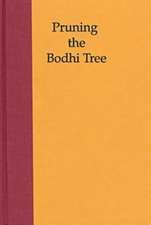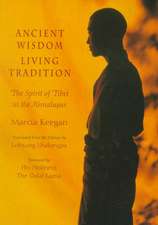Buddhisms: An Introduction
Autor John S. Strongen Limba Engleză Paperback – 11 aug 2015
"Exemplary for its organization and writing, this work is likely to become the standard single-volume text on Buddhism for the student, whether within the walls of the academy or without.”
—Starred Review, Library Journal
Buddhisms: An Introduction represents a novel way of presenting the whole of the Buddhist tradition in its unity and multiplicity. Clear in its explanations, replete with tables and suggestions for further reading, it should appeal to students, yet also be of interest to scholars for some of its ways of viewing the Buddha, his teachings, and the Buddhist community through the ages.
—Starred Review, Library Journal
Buddhisms: An Introduction represents a novel way of presenting the whole of the Buddhist tradition in its unity and multiplicity. Clear in its explanations, replete with tables and suggestions for further reading, it should appeal to students, yet also be of interest to scholars for some of its ways of viewing the Buddha, his teachings, and the Buddhist community through the ages.
Preț: 194.61 lei
Preț vechi: 209.53 lei
-7% Nou
Puncte Express: 292
Preț estimativ în valută:
37.24€ • 38.88$ • 30.82£
37.24€ • 38.88$ • 30.82£
Carte disponibilă
Livrare economică 14-28 martie
Livrare express 27 februarie-05 martie pentru 52.80 lei
Preluare comenzi: 021 569.72.76
Specificații
ISBN-13: 9781780745053
ISBN-10: 1780745052
Pagini: 496
Ilustrații: illustrations
Dimensiuni: 152 x 235 x 38 mm
Greutate: 0.64 kg
Editura: Oneworld Publications
Colecția Oneworld Publications
Locul publicării:United Kingdom
ISBN-10: 1780745052
Pagini: 496
Ilustrații: illustrations
Dimensiuni: 152 x 235 x 38 mm
Greutate: 0.64 kg
Editura: Oneworld Publications
Colecția Oneworld Publications
Locul publicării:United Kingdom
Recenzii
"Deftly selecting material from a vast tradition, Strong guides the reader through complex topics with precision, clarity, and insight, aided by tables presenting more abstruse information. Particularly cogent are his analyses of long-debated subjects such as karma, non-self, and approaches to enlightenment (practice/study, gradual/sudden). He includes topics related to women in Buddhism throughout.... Readers eager to dive into a rigorous, well-organized investigation of Buddhism's intricate 2500-year-old history will find much to reward them."
—Publishers Weekly
"Strong (religious studies, Bates Coll.) is well qualified to discuss Buddhism, having authored The Buddha and The Experience of Buddhism, among other titles. This substantial study is a near-comprehensive digest of the history of Buddhism in its multiple forms, from its origins in India to its variants in Thailand, Japan, and Tibet. Strong’s exhaustive account is doubtless intended as a textbook, yet it is also gratifying and accessible to all readers as it includes the lives (real and legendary) of Gautama Buddha, also known as Sakyamuni, as well as discussions of early monastic communities and clear expositions of most Buddhist doctrines. The latter part of the title focuses on several variants of Buddhism and contains chronologies of the tradition throughout Asia. VERDICT Exemplary for its organization and writing, this work is likely to become the standard single-volume text on Buddhism for the student, whether within the walls of the academy or without.”
— Starred Review, Library Journal
"Recommended .... Strong’s exhaustive study of Buddhisms is both accessible and informative. The volume’s greatest strength is the vast detail and breadth of Buddhism that it manages to cover while preserving a sense of what makes Buddhism what it is across a variety of geographic and temporal ranges. The breadth of the book notwithstanding, Strong (philosophy and religion, Bates College) does well to express the personal experience of Buddhism, and it is clear that this work is the result of decades of research. He opens with the modern day temple setting before moving to the root story of the experience of Sakyamuni (the Buddha). Having provided this background, the author proceeds to explain the process of institutionalization of the tradition and the various teachings. This serves as a beautiful transition to explaining the varieties of Buddhist expression in later developments in Mahayana and Vajrayana traditions outside the Indian context. By limiting the volume's scope to the Asian context, Strong is able to focus on some key elements of the religious tradition and its development."
—CHOICE Magazine, from the American Library Association
—Publishers Weekly
"Strong (religious studies, Bates Coll.) is well qualified to discuss Buddhism, having authored The Buddha and The Experience of Buddhism, among other titles. This substantial study is a near-comprehensive digest of the history of Buddhism in its multiple forms, from its origins in India to its variants in Thailand, Japan, and Tibet. Strong’s exhaustive account is doubtless intended as a textbook, yet it is also gratifying and accessible to all readers as it includes the lives (real and legendary) of Gautama Buddha, also known as Sakyamuni, as well as discussions of early monastic communities and clear expositions of most Buddhist doctrines. The latter part of the title focuses on several variants of Buddhism and contains chronologies of the tradition throughout Asia. VERDICT Exemplary for its organization and writing, this work is likely to become the standard single-volume text on Buddhism for the student, whether within the walls of the academy or without.”
— Starred Review, Library Journal
"Recommended .... Strong’s exhaustive study of Buddhisms is both accessible and informative. The volume’s greatest strength is the vast detail and breadth of Buddhism that it manages to cover while preserving a sense of what makes Buddhism what it is across a variety of geographic and temporal ranges. The breadth of the book notwithstanding, Strong (philosophy and religion, Bates College) does well to express the personal experience of Buddhism, and it is clear that this work is the result of decades of research. He opens with the modern day temple setting before moving to the root story of the experience of Sakyamuni (the Buddha). Having provided this background, the author proceeds to explain the process of institutionalization of the tradition and the various teachings. This serves as a beautiful transition to explaining the varieties of Buddhist expression in later developments in Mahayana and Vajrayana traditions outside the Indian context. By limiting the volume's scope to the Asian context, Strong is able to focus on some key elements of the religious tradition and its development."
—CHOICE Magazine, from the American Library Association
Notă biografică
John S. Strong is the Charles A. Dana Professor of Religion, Bates College, in Maine. Specializing in history of religions, Asian religions, and Buddhist Studies, with a focus on Buddhist legendary and cultic traditions in India and South Asia. He is the author of numerous books and articles including The Buddha: A Beginner’s Guide (Oneworld).
Cuprins
Preface
Schemes and Themes
Technicalities
Note on abbreviations
Chapter 1 Introduction: Lumbini, a Buddhist World Exposition
1.1 Theravada and Mahayana
1.2 Lumbini's Eastern Monastic Zone: South and Southeast Asian Traditions
1.2.1 The Maha Bodhi Society
1.2.2 The Sri Lanka Monastery
1.2.3 The Gautami Center for Nuns
1.2.4 Myanmar (Burma)
1.2.5 Meditation Centers
1.3 Lumbini's Western Monastic Zone: East Asian Traditions
1.3.1 China
1.3.2 Korea
1.3.3 Japan
1.3.4 Vietnam
1.4 Lumbini's Western Monastic Zone: Tibetan Vajrayana Traditions
1.4.1 The Great Lotus Stupa
1.4.2 The Lumbini Udyana Mahachaitya
Part I: Foundations of the Triple Gem: Buddha/s, Dharma/s, and Saṃgha/s
Chapter 2 Sakyamuni, Lives and Legends
2.1 The Historical Buddha
2.2 The Buddha's World
2.3 The Buddha of Story
2.4 Past Buddhas and the Biographical Blueprint
2.5 The Start of Sakyamuni's Career
2.6 Previous Lives (Jatakas)
2.6.1 The Donkey in the Lion's Skin
2.6.2 Vessantara Jataka
2.6.3 The Tigress Jataka
2.7 A Lifestory of Sakyamuni
2.7.1 Birth and Childhood
2.7.2 Life in the Palace
2.7.3 The Beginnings of Discontent
2.7.4 The Great Departure
2.7.5 Paths Not Taken
2.7.6 Awakening
2.7.7 After Enlightenment
2.7.8 The First Sermon
2.7.9 Various Conversions and Miracles
2.7.10 Death and Parinirvaṇa
Chapter 3 Overcoming the Buddha's Absence
3.1 Seeing the Buddha in the Dharma
3.1.1 Excursus on the Buddhist Canon/s
3.2 Places of Pilgrimage
3.3 Relics
3.4 Buddha Images
3.5 The Masters of the Dharma
3.6 The Arhat Dharma-Protectors
3.7 Meeting Maitreya
Chapter 4 Some Permutations of the Middle Way
4.1 The Middle Way
4.2 Karma and Saṃsara
4.2.1 Why Do Good Deeds?
4.2.2 Contexts of Karma I: Neither Free Will nor Determinism
4.2.3 Contexts of Karma II: Both Jain and Upani?adic Views
4.3 The Doctrine of Non-Self (Anatman)
4.3.1 Breaking Down the False Sense of Self: the Five Aggregates and Impermanence
4.3.2 The Elements (Dharmas)
4.3.3 Countering the Breakdown of Self: Personal Continuity
4.3.4 Explications of Continuity: Pseudo-Selves and Ersatz Atmans
4.4 Summary
Chapter 5 The Four Truths
5.1 The First Truth: Stress
5.2 The Second Truth: the Continual Arising of Stress and Interdependent Origination
5.2.1 The Double Bind of Saṃsara
5.3 The Third Truth: the Cessation of Stress ? Nirvaṇa
5.4 The Fourth Truth: the Path to the Cessation of Stress
5.4.1 Moral Discipline
5.4.2 Meditation
5.4.3 Wisdom
5.5 Other Systematizations of the Path
5.5.1 The Seven Factors Conducive to Enlightenment
5.5.2 The Graduated Training
5.5.3 The Four Divine Abidings
5.5.4 The Four Fruits of the Path
5.6 Summary
Chapter 6 The Establishment and Character of the Early Buddhist Community
6.1 Monastic?Lay Interactions
6.1.1 Dana (Giving) and Other Forms of Making Merit
6.1.2 Lay Ethics
6.1.3 Magical Protection
6.1.4 Laypersons and the Monastic Rules
6.1.5 Royal Supporters
6.1.6 King Asoka
6.2 The Monastics: Wandering and Settling
6.2.1 Monastic Lifestyles
6.2.2 Monasteries
6.3 Mahaprajapati and the Establishment of the Order of Nuns
6.4 Common Moral Commitments
6.5 Initiation Rituals: Wandering Forth and Ordination
6.6 Monastic Rules
6.6.1 The Elaboration of the Disciplinary Code
6.6.2 Enforcement of the Rules: Pratimok?a Recitation and Pravaraṇa
6.7 Some Exemplary Disciples of the Buddha
6.7.1 Sariputra and Maudgalyayana
6.7.2 Pa?acara
6.7.3 The Laypersons Nakulapitṛ and Nakulamatṛ
6.7.4 Visakha, Preeminent Laywoman
6.8 Summary
Chapter 7 Visions and Divisions of the Saṃgha
7.1 Council Stories
7.1.1 The Council at Rajagṛha
7.1.2 Vinaya Disputes: the Council of Vaisali
7.1.3 The Councils of Pa?aliputra
7.1.4 Other Council Traditions
7.2 The Flowering of Mainstream Factionalism
7.3 Other Divisional Issues
7.3.1 Practice vs. Study
7.3.2 Meditators and Merit Makers
7.3.3 Forest Monks and Town Monks
7.3.4 The Question of Asceticism
7.3.5 The Question of Bon-Vivant Monks
7.3.6 Sect vs. Sect
7.4 The Origins of the Mahayana
7.5 Proliferation of Mahayana Schools
7.5.1 Mahayana Schools in India
7.5.2 Mahayana Schools in China
7.5.3 Mahayana Schools in Japan
7.5.4 Mahayana Schools in Tibet
7.6 Summary
Part II: Further Elaborations of the Triple Gem
Chapter 8 Mahayana and Vajrayana Ways of Meeting the Buddha/s
8.1 Changes in the View of the Buddha: the Lotus Sutra and Sakyamuni's Lifespan
8.2 Three Bodies of the Buddha/s
8.3 Meeting the Buddha/s in Their Pure Lands
8.3.1 Ak?obhya
8.3.2 Bhai?ajyaguru
8.4 Amitabha
8.4.1 Meeting Amitabha through Visualization
8.4.2 Rebirth in the Pure Land
8.5 Meeting the Buddha in the Great Bodhisattvas
8.5.1 Avalokitesvara
8.5.2 Other Great Bodhisattvas
8.6 Meeting the Buddha/s in the Vajrayana
8.6.1 Maṇ?alas and the Five Tathagatas
8.6.2 Ritual Consecration (Abhi?eka)
8.6.3 Merging with the Buddha
8.6.4 Visions: Meeting the Buddha/s in Bardo
8.6.5 Buddha Embodiments in This World: Gurus and Tülkus
8.7 Summary
Chapter 9 Mahayana Doctrinal Developments
9.1 Emptiness: the Selflessness of Dharmas
9.2 Nagarjuna and the Madhyamaka
9.3 The Expansion of Provisional Truth: Expedient Means (Upaya)
9.4 Tiantai Doctrines
9.5 The Ongoing Dialectic: the Yogacara School
9.5.1 Asanga and Vasubandhu and the Development of the School
9.5.2 Yogacara Doctrines
9.6 Avataṃsaka Doctrines
9.6.1 Applications of Interpenetration
9.7 The Buddha Womb/Embryo (Tathagatagarbha) Teachings
9.7.1 Resurgence of the True Self
9.8 Buddha-Nature Controversies
9.8.1 Limitations to the Buddha-Nature: the Icchantika Debate
9.8.2 The End of the Dharma
9.8.3 Expansions of the Buddha-Nature Doctrine
9.9 Summary
Chapter 10 The Bodhisattva Path, Tantra, and Zen
10.1 The Bodhisattva Path
10.2 Sudden and Gradual
10.2.1 Disagreements over the Nature of the Path: the Debate at Samyé
10.2.2 Disagreements over the Nature of Enlightenment
10.3 Graduated Paths
10.3.1 Compassion and Bodhicitta
10.3.2 The Stages of the Path, the Perfections, the Five Paths
10.3.3 Routinization and Ritualization
10.4 Path Shortcuts
10.5 Tantra
10.5.1 Uniting the Poles
10.5.2 Tantric Physiology
10.5.3 Mahamudra and Dzokchen (Rdzogs chen)
10.6 Direct Experiences: Chan/Zen
10.6.1 Koans
10.6.2 Critical Phrases (Huatou)
10.7 Summary
Chapter 11 Saṃgha Situations: Places, Persons, and Practices in Thai Buddhism/s
11.1 Buddhism in Thailand
11.2 Thai Monastic Life: Temporary Ordination
11.2.1 Life as a Novice
11.2.2 Experiences as a Monk
11.3 The Lives of Two Charismatic Thai Monks
11.3.1 Acharn Mun
11.3.2 Khruba Siwichai
11.4 The End of the Rains-Retreat in a Northern Thai Village
11.5 A Thai Temple in Wimbledon, England
Chapter 12 Saṃgha Situations: Places, Persons, and Practices in Japanese Buddhism/s
12.1 The Hexagonal Hall (Rokkakudo)
12.1.1 Prince Shotoku
12.1.2 Shinran
12.1.3 Kannon, Jizo, and Fudo
12.2 The Ritual Year at Shinnyodo
12.2.1 New Year's
12.2.2 ?akini and the Recitation of the Great Perfection of Wisdom Sutra
12.2.3 Main Hall Rituals
12.2.4 Goma
12.2.5 The Killing Stone
12.3 The Ryoanji Rock Garden
12.4 The Buddha's Birthday at the Morgan Bay Zendo
12.5 The Japan Temple in Lumbini
12.6 Conclusion
Chapter 13 Saṃgha Situations: Places, Persons, and Practices in Tibetan Buddhism/s
13.1 Lhasa Jokhang
13.1.1 Pinning Down the Demoness
13.1.2 Flood Control
13.1.3 Grand Prostrations
10.1.4 The Great Prayer Festival
13.2 The Potala and the Dalai Lamas
13.2.1 Finding a New Dalai Lama
13.3 Scholars and Mad Saints
13.3.1 Drepung Monastery and Monastic Studies
13.3.2 Mad Monks: the Case of Tangtong Gyalpo
13.4 Samding: Female Incarnations and a Contemporary Buddhist
13.5 A Tibetan Dharma Center in Vermont, U.S.A.
13.6 Conclusion
Appendices
Appendix A: A Short Chronology of Buddhism in India
Appendix B: A Short Chronology of Buddhism in Sri Lanka
Appendix C: A Short Chronology of Buddhism in Myanmar (Burma)
Appendix D: A Short Chronology of Buddhism in Cambodia
Appendix E: A Short Chronology of Buddhism in Thailand
Appendix F: A Short Chronology of Buddhism in China
Appendix G: A Short Chronology of Buddhism in Japan
Appendix H: A Short Chronology of Buddhism in Vietnam
Appendix I: A Short Chronology of Buddhism in Tibet
Bibliography of Works Cited
Index
Schemes and Themes
Technicalities
Note on abbreviations
Chapter 1 Introduction: Lumbini, a Buddhist World Exposition
1.1 Theravada and Mahayana
1.2 Lumbini's Eastern Monastic Zone: South and Southeast Asian Traditions
1.2.1 The Maha Bodhi Society
1.2.2 The Sri Lanka Monastery
1.2.3 The Gautami Center for Nuns
1.2.4 Myanmar (Burma)
1.2.5 Meditation Centers
1.3 Lumbini's Western Monastic Zone: East Asian Traditions
1.3.1 China
1.3.2 Korea
1.3.3 Japan
1.3.4 Vietnam
1.4 Lumbini's Western Monastic Zone: Tibetan Vajrayana Traditions
1.4.1 The Great Lotus Stupa
1.4.2 The Lumbini Udyana Mahachaitya
Part I: Foundations of the Triple Gem: Buddha/s, Dharma/s, and Saṃgha/s
Chapter 2 Sakyamuni, Lives and Legends
2.1 The Historical Buddha
2.2 The Buddha's World
2.3 The Buddha of Story
2.4 Past Buddhas and the Biographical Blueprint
2.5 The Start of Sakyamuni's Career
2.6 Previous Lives (Jatakas)
2.6.1 The Donkey in the Lion's Skin
2.6.2 Vessantara Jataka
2.6.3 The Tigress Jataka
2.7 A Lifestory of Sakyamuni
2.7.1 Birth and Childhood
2.7.2 Life in the Palace
2.7.3 The Beginnings of Discontent
2.7.4 The Great Departure
2.7.5 Paths Not Taken
2.7.6 Awakening
2.7.7 After Enlightenment
2.7.8 The First Sermon
2.7.9 Various Conversions and Miracles
2.7.10 Death and Parinirvaṇa
Chapter 3 Overcoming the Buddha's Absence
3.1 Seeing the Buddha in the Dharma
3.1.1 Excursus on the Buddhist Canon/s
3.2 Places of Pilgrimage
3.3 Relics
3.4 Buddha Images
3.5 The Masters of the Dharma
3.6 The Arhat Dharma-Protectors
3.7 Meeting Maitreya
Chapter 4 Some Permutations of the Middle Way
4.1 The Middle Way
4.2 Karma and Saṃsara
4.2.1 Why Do Good Deeds?
4.2.2 Contexts of Karma I: Neither Free Will nor Determinism
4.2.3 Contexts of Karma II: Both Jain and Upani?adic Views
4.3 The Doctrine of Non-Self (Anatman)
4.3.1 Breaking Down the False Sense of Self: the Five Aggregates and Impermanence
4.3.2 The Elements (Dharmas)
4.3.3 Countering the Breakdown of Self: Personal Continuity
4.3.4 Explications of Continuity: Pseudo-Selves and Ersatz Atmans
4.4 Summary
Chapter 5 The Four Truths
5.1 The First Truth: Stress
5.2 The Second Truth: the Continual Arising of Stress and Interdependent Origination
5.2.1 The Double Bind of Saṃsara
5.3 The Third Truth: the Cessation of Stress ? Nirvaṇa
5.4 The Fourth Truth: the Path to the Cessation of Stress
5.4.1 Moral Discipline
5.4.2 Meditation
5.4.3 Wisdom
5.5 Other Systematizations of the Path
5.5.1 The Seven Factors Conducive to Enlightenment
5.5.2 The Graduated Training
5.5.3 The Four Divine Abidings
5.5.4 The Four Fruits of the Path
5.6 Summary
Chapter 6 The Establishment and Character of the Early Buddhist Community
6.1 Monastic?Lay Interactions
6.1.1 Dana (Giving) and Other Forms of Making Merit
6.1.2 Lay Ethics
6.1.3 Magical Protection
6.1.4 Laypersons and the Monastic Rules
6.1.5 Royal Supporters
6.1.6 King Asoka
6.2 The Monastics: Wandering and Settling
6.2.1 Monastic Lifestyles
6.2.2 Monasteries
6.3 Mahaprajapati and the Establishment of the Order of Nuns
6.4 Common Moral Commitments
6.5 Initiation Rituals: Wandering Forth and Ordination
6.6 Monastic Rules
6.6.1 The Elaboration of the Disciplinary Code
6.6.2 Enforcement of the Rules: Pratimok?a Recitation and Pravaraṇa
6.7 Some Exemplary Disciples of the Buddha
6.7.1 Sariputra and Maudgalyayana
6.7.2 Pa?acara
6.7.3 The Laypersons Nakulapitṛ and Nakulamatṛ
6.7.4 Visakha, Preeminent Laywoman
6.8 Summary
Chapter 7 Visions and Divisions of the Saṃgha
7.1 Council Stories
7.1.1 The Council at Rajagṛha
7.1.2 Vinaya Disputes: the Council of Vaisali
7.1.3 The Councils of Pa?aliputra
7.1.4 Other Council Traditions
7.2 The Flowering of Mainstream Factionalism
7.3 Other Divisional Issues
7.3.1 Practice vs. Study
7.3.2 Meditators and Merit Makers
7.3.3 Forest Monks and Town Monks
7.3.4 The Question of Asceticism
7.3.5 The Question of Bon-Vivant Monks
7.3.6 Sect vs. Sect
7.4 The Origins of the Mahayana
7.5 Proliferation of Mahayana Schools
7.5.1 Mahayana Schools in India
7.5.2 Mahayana Schools in China
7.5.3 Mahayana Schools in Japan
7.5.4 Mahayana Schools in Tibet
7.6 Summary
Part II: Further Elaborations of the Triple Gem
Chapter 8 Mahayana and Vajrayana Ways of Meeting the Buddha/s
8.1 Changes in the View of the Buddha: the Lotus Sutra and Sakyamuni's Lifespan
8.2 Three Bodies of the Buddha/s
8.3 Meeting the Buddha/s in Their Pure Lands
8.3.1 Ak?obhya
8.3.2 Bhai?ajyaguru
8.4 Amitabha
8.4.1 Meeting Amitabha through Visualization
8.4.2 Rebirth in the Pure Land
8.5 Meeting the Buddha in the Great Bodhisattvas
8.5.1 Avalokitesvara
8.5.2 Other Great Bodhisattvas
8.6 Meeting the Buddha/s in the Vajrayana
8.6.1 Maṇ?alas and the Five Tathagatas
8.6.2 Ritual Consecration (Abhi?eka)
8.6.3 Merging with the Buddha
8.6.4 Visions: Meeting the Buddha/s in Bardo
8.6.5 Buddha Embodiments in This World: Gurus and Tülkus
8.7 Summary
Chapter 9 Mahayana Doctrinal Developments
9.1 Emptiness: the Selflessness of Dharmas
9.2 Nagarjuna and the Madhyamaka
9.3 The Expansion of Provisional Truth: Expedient Means (Upaya)
9.4 Tiantai Doctrines
9.5 The Ongoing Dialectic: the Yogacara School
9.5.1 Asanga and Vasubandhu and the Development of the School
9.5.2 Yogacara Doctrines
9.6 Avataṃsaka Doctrines
9.6.1 Applications of Interpenetration
9.7 The Buddha Womb/Embryo (Tathagatagarbha) Teachings
9.7.1 Resurgence of the True Self
9.8 Buddha-Nature Controversies
9.8.1 Limitations to the Buddha-Nature: the Icchantika Debate
9.8.2 The End of the Dharma
9.8.3 Expansions of the Buddha-Nature Doctrine
9.9 Summary
Chapter 10 The Bodhisattva Path, Tantra, and Zen
10.1 The Bodhisattva Path
10.2 Sudden and Gradual
10.2.1 Disagreements over the Nature of the Path: the Debate at Samyé
10.2.2 Disagreements over the Nature of Enlightenment
10.3 Graduated Paths
10.3.1 Compassion and Bodhicitta
10.3.2 The Stages of the Path, the Perfections, the Five Paths
10.3.3 Routinization and Ritualization
10.4 Path Shortcuts
10.5 Tantra
10.5.1 Uniting the Poles
10.5.2 Tantric Physiology
10.5.3 Mahamudra and Dzokchen (Rdzogs chen)
10.6 Direct Experiences: Chan/Zen
10.6.1 Koans
10.6.2 Critical Phrases (Huatou)
10.7 Summary
Chapter 11 Saṃgha Situations: Places, Persons, and Practices in Thai Buddhism/s
11.1 Buddhism in Thailand
11.2 Thai Monastic Life: Temporary Ordination
11.2.1 Life as a Novice
11.2.2 Experiences as a Monk
11.3 The Lives of Two Charismatic Thai Monks
11.3.1 Acharn Mun
11.3.2 Khruba Siwichai
11.4 The End of the Rains-Retreat in a Northern Thai Village
11.5 A Thai Temple in Wimbledon, England
Chapter 12 Saṃgha Situations: Places, Persons, and Practices in Japanese Buddhism/s
12.1 The Hexagonal Hall (Rokkakudo)
12.1.1 Prince Shotoku
12.1.2 Shinran
12.1.3 Kannon, Jizo, and Fudo
12.2 The Ritual Year at Shinnyodo
12.2.1 New Year's
12.2.2 ?akini and the Recitation of the Great Perfection of Wisdom Sutra
12.2.3 Main Hall Rituals
12.2.4 Goma
12.2.5 The Killing Stone
12.3 The Ryoanji Rock Garden
12.4 The Buddha's Birthday at the Morgan Bay Zendo
12.5 The Japan Temple in Lumbini
12.6 Conclusion
Chapter 13 Saṃgha Situations: Places, Persons, and Practices in Tibetan Buddhism/s
13.1 Lhasa Jokhang
13.1.1 Pinning Down the Demoness
13.1.2 Flood Control
13.1.3 Grand Prostrations
10.1.4 The Great Prayer Festival
13.2 The Potala and the Dalai Lamas
13.2.1 Finding a New Dalai Lama
13.3 Scholars and Mad Saints
13.3.1 Drepung Monastery and Monastic Studies
13.3.2 Mad Monks: the Case of Tangtong Gyalpo
13.4 Samding: Female Incarnations and a Contemporary Buddhist
13.5 A Tibetan Dharma Center in Vermont, U.S.A.
13.6 Conclusion
Appendices
Appendix A: A Short Chronology of Buddhism in India
Appendix B: A Short Chronology of Buddhism in Sri Lanka
Appendix C: A Short Chronology of Buddhism in Myanmar (Burma)
Appendix D: A Short Chronology of Buddhism in Cambodia
Appendix E: A Short Chronology of Buddhism in Thailand
Appendix F: A Short Chronology of Buddhism in China
Appendix G: A Short Chronology of Buddhism in Japan
Appendix H: A Short Chronology of Buddhism in Vietnam
Appendix I: A Short Chronology of Buddhism in Tibet
Bibliography of Works Cited
Index

















